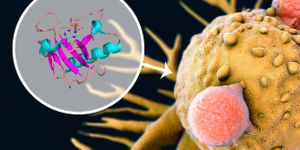Natural HIV Resistance
The human immunodeficiency virus, as it stands today, has no cure. There are of course other options available to patients of HIV such as antiretroviral therapy, that allow somewhat of a normal life to exist. Scientists are always on the search for the Holy Grail information that might bring them closer to the removal of the virus altogether. In a recent study, a clue is revealed that may indeed aid researchers on their road to a cure.
Somewhere in the range of 40 million individuals worldwide are infected with HIV, and among them exist about one percent of patients whose immune systems can fend off the virus without the use of therapy. The one percent has immune systems that recognize HIV and mount an attack before the virus can effectively infect the host cells at the rate it would in the other 99 percent.
A team of researchers at Centre de Recherche du Centre Hospitalier de l'Université de Montréal (CRCHUM), collaborate with researchers at the Laboratory of Antiviral Immunity of Université du Québec à Trois-Rivières (UQTR) to discover that genetic mutations affecting the capsid, the structure surrounding the HIV genome, make it possible for a protein called TRIM5α to trigger the immune system of the one percent or as the author likes to call them, the elite controllers.
The team shares that, “Some HIV-1-infected individuals show a natural capacity to control viral propagation. In individuals that have the HLA B27 or B57 allele, HIV-1 control is associated with mutations in viral proteins that arise as a result of immune pressure from cytotoxic T lymphocytes.” HLA stands for human leukocyte antigen, and it is involved in the regulation of the immune system in humans.
Innate to the host are particular proteins known as cytoplasmic effectors which target retroviral capsids. Capsids are the structures which protect the virus’s ribonucleic acid or RNA. In this case, the researchers look closely at the protein called TRIM5α. "Our goal was to examine a specific part of the virus: the capsid -- it's the 'virus coat,' which determines sensitivity to TRIM5α," explained Berthoux, who directed the study.
As the capsid undergoes immune attacks, it also undertakes multiple mutations to aid in their escape from the immune system. The scientists involved can display that the mutations in the capsid gene are linked to the HIV-1 sensitivity to TRIM5α and its ability to keep the viral propagation at bay.
The team shares, “We show here that HIV-1 bearing such mutations is restricted by the capsid-targeting innate effector, TRIM5α. As a result, cells have decreased permissiveness to subsequent HIV-1 infections, a phenomenon that could contribute to the inefficient disease progression observed in these individuals.”
The team hopes this bit of information will aid in the understanding of how HIV-1 can be naturally evaded. The research team suggests, “This knowledge might find applications in the development of immune interventions to increase human cells resistance to HIV-1.”
Sources: PLOS Pathogens, Science Daily, YouTube









